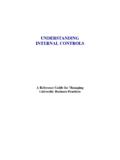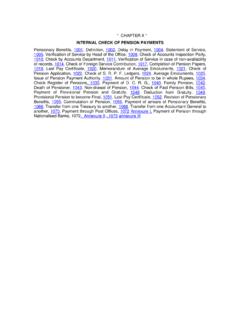Transcription of Exemplar for Internal Assessment Resource Economics …
1 Exemplar for Internal Assessment Resource Economics for Achievement Standard 90984 Exemplar for Internal Assessment Resource Economics Level 1 Resource title: Taking a Look at McDonald s Restaurants (NZ) Ltd This Exemplar supports Assessment against: Achievement Standard 90984 Demonstrate Understanding of Decisions a Producer Makes About Production Expected responses The moderators have developed expected student response from a wide variety of sources. Date version published by Ministry of Education December 2010 To support Internal Assessment from 2011 Crown 2010 Exemplar for Internal Assessment Resource Classics for Achievement Standard 90250 Crown 2010 Grade Boundary: Low Excellence 1.
2 Overall, the student has demonstrated a comprehensive understanding of decisions a producer makes about production. The student has integrated supporting data (figures from the table and from Resource A) into detailed explanations of producer decisions in relation to production and productivity. The student has linked the production decision of training staff to improve productivity via specialisation and division of labour to the positive consequence to the producer and explained a negative consequence to society of the producer decision to cut staff numbers. The student has fully explained production increases and decreases from a macro viewpoint, using appropriate economic language, and has linked these explanations to consequences to the producer and explained some of the flow-on effects to society.
3 The commercial goals are not fully explained and have no examples incorporated into the explanations. However, the student has explained the non-commercial goals and production decisions of using price and non-price strategies in detail using examples from gathered information, and linked these back to the relevant commercial goals and explained the consequences to the producer. Production decisions have been linked to explanations of negative consequences to society, but detailed explanations would include the positive social consequences as well. "McDonalds supports local producers and businesses by ordering ingredients from them, competition in the takeaways industry often leads to cheaper prices for consumers, and the healthy options added to the menu list means better quality ingredients are being used.
4 The community service and expenditure on local charities is of huge assistance to organisations that may otherwise not be able to afford to continue offering their services. The business growth through franchising means greater employment, and the expenditure and profit means greater growth for the NZ economy." TASK 2 Productivity Table Year Production of Top 8 burgers Percentage Change Labour Productivity (Burgers/Workers) 2007 46,241,971 2008 47,915,640 2009 46,965,170 Productivity Productivity is looking at output/inputs to see how efficiently the production process is working.
5 McDonalds is very good at reviewing all parts of the process and finding ways to make it more efficient so they can cut costs of production, so increase profit and control safety and quality management. They know down to the second how long each stage should take, for instance their time management in production for cooking; the beef patties are cooked for just the right amount of time that's a minimum of 36 seconds for a regular patty and a minimum of 101 seconds for a Quarter Pounder patty. If the staff levels remained the same (approx. 8000) between 2007 and 2008 then productivity of labour has improved by annually or weekly 4 per worker. This could be due to improved training by McDonalds to improve specialisation and division of labour has been applied to the production tasks.
6 The resulting gain in productivity means the production process has become more profitable for the producer. The decrease in productivity of labour between 2008 and 2009 is only true if staff numbers stayed the same, but in reality McDonalds may have reduced staff numbers or reduced their hours to part-time to cut the cost of labour, because of the reduced demand by consumers in 2009, which has resulted in decreased production of the Top 8 burgers, this means less income for workers as they have reduced hours or they have become unemployed. Production Production is the process of transforming inputs into output (goods or services), or in this case resources like raw ingredients, capital goods and labour.
7 Workers then cook using capital goods like ovens and change these raw ingredients into burgers, and serve them to customers. Production of the Top 8 burgers increased by from 2007 to 2008, this increase in consumer demand could have been due to a successful advertising campaign that promoted their burgers, and consumers had more disposable income to spend, maybe due to tax cuts or the economy was stronger. The producer has increased production of burgers to meet this increased demand, so has increased supply, this will result in increased revenue for the producer and for the mainly New Zealand suppliers of the ingredients. But from 2008 to 2009 production worsened with negative growth of , this was about the same time as the global recession started, so demand for takeaways decreased because this is a luxury good and when income decreases consumers focus on buying only the necessities like groceries.
8 The producer will have taken a loss in revenue and most likely profit as well because they may have purchased more capital goods or hired more staff to meet the increased production needs of the previous year. This decreased revenue and profit also has negative consequences to society as well because workers may be laid off which reduces their income, the NZ suppliers who rely on McDonalds demand for their goods receive less revenue as well, and the government will receive less tax revenue from all these firms and households and also will have to pay out more in benefits to those unemployed. TASK 3 Commercial Goals McDonalds goals are profit maximisation, sales maximisation, increased market share of the takeaways industry, and business expansion through selling more franchises, setting up more McDonalds outlets throughout New Zealand.
9 Non-Commercial Goals Some of the non-commercial goals are corporate responsibility (purchasing from mainly NZ suppliers). One of the positive benefits of McDonalds purchasing off NZ suppliers is the income this provides for other businesses in the NZ economy and for the consumers who work in these businesses. Community goals include helping to set up the Ronald McDonald House charities, and supporting Variety-The children s Charity. Environmental goals include the 3Rs-reduce, re-use, and recycle and supporting Clean up NZ week. The franchising arrangement means many local business people run the restaurants and help out local junior sports teams and at other community events. The AUT scholarships assist M ori from Northland to attain tertiary qualifications.
10 Special Christmas parties are organised for disadvantaged and disabled children around NZ. The environmental goals encourage reducing waste and support the clean-up of NZ campaign in September every year. Price Strategies McDonalds reduces prices to try and increase sales like their six lunch deals from $ , value picks 6 items under $3 each, combo deals, limited time specials, and cheap burger coupons (on the back of supermarket till receipts). These strategies are designed to increase sales; once the consumers come in for the cheap items they may buy other items as well, so increasing revenue and profit for the producer. Non-Price Strategies McDonalds promotes sales without changing price like product variation (actual different products) including a Breakfast menu, M selections range, and McCafe to appeal to different tastes and preferences and income brackets, and healthy alternatives (fruit bags) to try to attract the more health conscious consumers.








